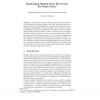11 search results - page 2 / 3 » Bounds on the Capacity of Channels with Insertions, Deletion... |
TIT
2010
13 years 3 days ago
2010
We directly lower bound the information capacity for channels with i.i.d. deletions and duplications. Our approach differs from previous work in that we focus on the information ca...
FUIN
2010
13 years 3 months ago
2010
Abstract. A (combinatorial) channel consists of pairs of words representing all possible inputoutput channel situations. In a past paper, we formalized the intuitive concept of “...
COLING
1990
13 years 6 months ago
1990
This paper describes a new program, correct, which takes words rejected by the Unix spell program, proposes a list of candidate corrections, and sorts them by probability. The pro...
IANDC
2007
13 years 5 months ago
2007
The edit distance (or Levenshtein distance) between two words is the smallest number of substitutions, insertions, and deletions of symbols that can be used to transform one of the...
IGIS
1994
13 years 9 months ago
1994
During the last decade various spatial data structures have been designed and compared against each other, all of them re ecting a dynamic situation with ongoing object insertion a...

